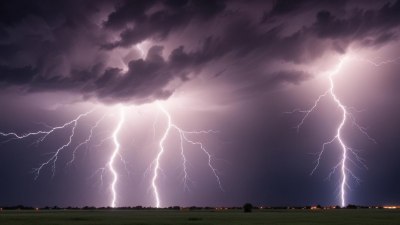The Science Behind Africa’s Endless Sunshine and Surprising Snow
Explore the unique climate of Africa, examining its abundant sunshine and rare snow occurrences.

This image was created with the assistance of Freepik
Africa, known for its vast landscapes and rich biodiversity, presents a climatic paradox: while it is celebrated for its abundant sunshine, it also surprises with occasional snow. This article delves into the atmospheric science behind Africa’s weather patterns, exploring the interplay of geography, climate, and meteorological phenomena that lead to both endless sunshine and rare snowfall across the continent.
The Geography of Africa
Africa is the second-largest continent, featuring diverse geographical features, including deserts, mountains, savannas, and tropical rainforests. These varying landscapes dramatically influence local climates. The Sahara Desert, covering much of North Africa, is one of the sunniest places on Earth, receiving an average of 3,600 hours of sunshine annually.
In contrast, areas like the Ethiopian Highlands and the Drakensberg Mountains in South Africa experience vastly different weather patterns due to altitude and elevation. The high altitude of these regions allows for cooler temperatures which can even lead to snowfall under the right conditions.
The Sunniest Regions of Africa
Regions that experience incredible amounts of sunshine are predominantly found in North Africa and parts of Southern Africa. The Sahara Desert not only exemplifies the harsh, dry climate but also sets a record for sunshine hours. Furthermore, cities like Aswan, Egypt, and Walvis Bay, Namibia, boast clear skies and warm temperatures year-round. This abundance of sunshine is attributed to various climatic factors including high pressure systems and the subtropical ridge.
Factors Contributing to Abundant Sunshine
1. High-Pressure Systems: Most of North Africa lies within the subtropical high-pressure zone, where descending air suppresses cloud formation, leading to clear skies and prolonged periods of sunshine.
2. Altitude: Even within regions famous for sunshine, altitude plays a key role. In mountainous areas, the thin atmosphere can lead to less cloud coverage due to limited moisture retention.
3. Geographical Location: Proximity to the equator influences sunlight intensity, with regions closer to the equator receiving more direct sunlight year-round compared to higher latitudes.
The Mechanism Behind Snowfall in Africa
Snow in Africa, though rare and often surprising, does occur in specific regions. The mountainous terrains are the primary areas where snowfall is witnessed, particularly during winter months. Locations such as the Atlas Mountains in Morocco and the Drakensberg Mountains in South Africa have reported snow, attributing this phenomenon to elevation and specific meteorological patterns.
1. Temperature Disparities: In many of Africa's high-altitude regions, temperatures can drop significantly during the night, particularly in winter. This drop can lead to precipitation falling as snow instead of rain.
2. Moisture Availability: Snow occurs when there is sufficient moisture in the atmosphere combined with low temperatures. Areas adjacent to larger bodies of water, such as the Mediterranean Sea, may experience snowfall when cold fronts move through during winter months.
3. Cold Fronts and Storm Systems: Occasionally, cold fronts from polar regions can push southward into Africa, bringing colder temperatures and conducive conditions for snowfall, particularly in mountainous areas during the winter months.
Snowfall in Specific Areas
Snowfall in Africa tends to occur in very localized regions. The Atlas Mountains in Morocco frequently receive snow, which supports winter sports and tourism. In South Africa, regions like the Drakensberg see snow during the winter months, attracting visitors to experience the unique climate.
Interestingly, the eastern highlands of Ethiopia receive snowfall as well, particularly at high altitudes, creating unique ecosystems and supporting diverse wildlife.
Impacts of Climate Change
As global temperatures rise, the implications for Africa’s climate are significant. While the continent is often recognized for its sunshine, climate change may result in altered weather patterns, potentially affecting rainfall distribution and snow occurrences in mountainous regions.
1. Increased Temperatures: Rising temperatures can lead to more evaporation, potentially reducing moisture availability necessary for snow formation in areas typically prone to snowfall.
2. Changing Weather Patterns: The alteration of meteorological systems may lead to unpredictable weather. While some regions may experience more extreme droughts, others may see unexpected storms, disrupting traditional patterns of sunshine and snowfall.
3. Impact on Ecosystems: Changes in snowfall patterns will lead to changes in water supply for many ecosystems and agricultural areas in Africa, as snowmelt is often a crucial water source during dryer months.
Tourism and Economic Impact
The unique combination of sunshine and snow in Africa creates varied opportunities for tourism. Many regions that experience high amounts of sunshine year-round attract tourists looking to escape colder climates, while the rare snowfall in mountain regions creates unique winter sports opportunities.
1. Winter Sports: Ski resorts in the Atlas Mountains and the Drakensberg have emerged, attracting both local and international tourists. This developing winter tourism industry benefits local economies and provides jobs.
2. Adventure Tourism: The diverse climates allow for various adventure activities. Visitors can explore vast deserts, enjoy sun-soaked beaches, or engage in winter sports, making Africa a prime destination for outdoor enthusiasts.
3. Wildlife and Conservation: Additionally, the climatic diversity supports a wide range of ecosystems and wildlife, providing significant opportunities for ecotourism, with visitors eager to explore Africa’s rich biodiversity under the sun and during the rare winter moments.
Cultural Significance
Africa's varied climates have also shaped its cultures and traditions. The stark contrast between the endless sunshine in some regions and the surprising snowfall in others influences lifestyle, agriculture, and cultural practices.
1. Agricultural Practices: Understanding the local climate influences how communities farm and cultivate their land. Areas that receive snowfall often engage in different agricultural cycles compared to those basking in constant sun.
2. Cultural Celebrations: Some regions celebrate seasonal changes, with festivals and traditions centered around the climate, showcasing the diversity of experiences across the continent.
3. Adapting to Climate Change: Cultural adaptations to changing weather patterns demonstrate the resilience of African communities. Many have developed practices aimed at managing water resources and adapting to shifts in climate.
Conclusion
The juxtaposition of endless sunshine and surprising snowfall across Africa illustrates the continent's climate complexity. Understanding the underlying scientific principles not only enriches our knowledge of regional weather patterns but also emphasizes the significance of adapting and preparing for future climate challenges. Africa continues to captivate the world with its unique climatic features, displaying both the intensity of the golden sun and the rarity of white snow. Whether basking in sunlight on a shoreline or marveling at snowfall in the mountains, Africa's diverse climates offer an extraordinary experience.











